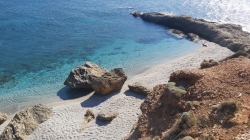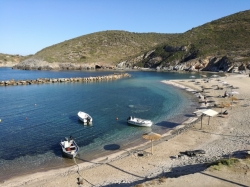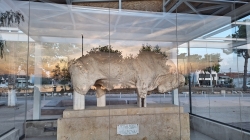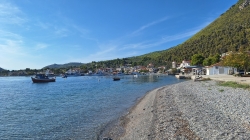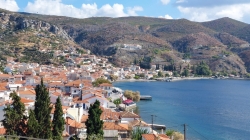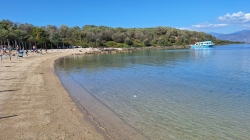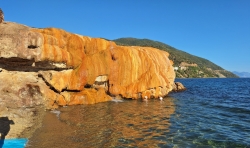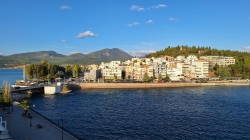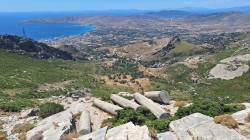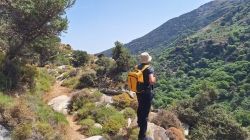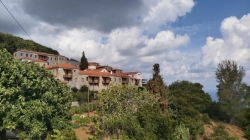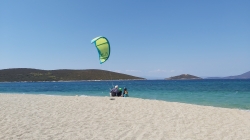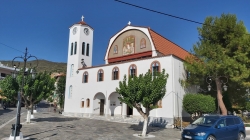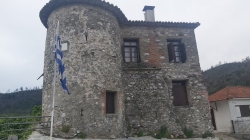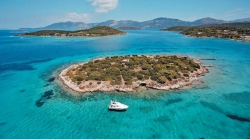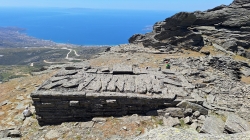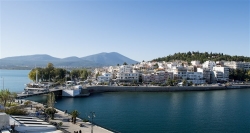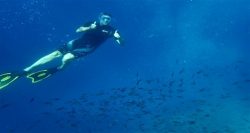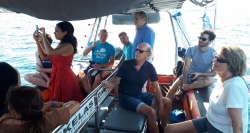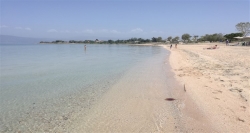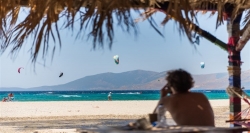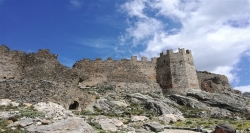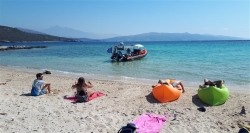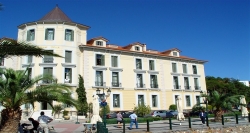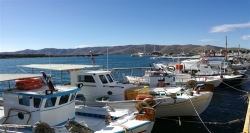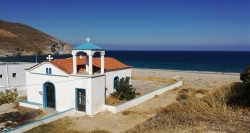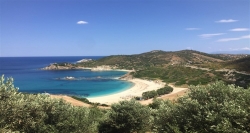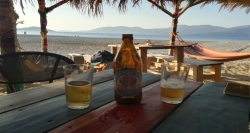Le nostre destinazioni più richieste
I nostri tour:
Common description
The large unknown island of the Aegean
The ideal compromise for those looking for tranquility, landscapes, nature, fantastic beaches and an authentic Greece!
Evia or Eubèa, which the Venetians called Negroponte, is the ideal destination for those who don't like too touristy places. Adjacent to part of the coast of Attica and only 1 hour from Athens is the second largest island in Greece.
The capital is Chalcis (Chalkida), a lively city of 120,000 inhabitants straddling the mainland and the island from which it is joined by bridges.
Mainly mountainous, with small fertile plains used for the cultivation of olive trees, vines, cereals and fruit, it presents great diversity: the north is very green and similar to the Sporades islands; the center with high mountains that plunge into the blue Aegean Sea; the south very similar to the Cyclades.
What to see and what to do in Evia: our suggestions
Central Evia
Chalcis (Chalkida), built on the Euripo Strait, is the most important center and capital of Evia. It is a modern city that stands out for its numerous restaurants, typical clubs and nightlife. Also called the city of the sacred Arethusa spring, Chalcis owes the etymological root of its name to the noun "chalkòs" (=bronze) and to the artisan metalworking workshops that were located in this area. The oldest written testimony on the existence of Chalcis (Chalkida) comes from Homer's epic poems, in particular from the Iliad (Book II, 536-541) where the city is mentioned in the list of ships of the Achaean fleet.
Nea Artaki is a fishing town just 10km from Chalkida; it is not famous for its beaches but for the numerous taverns, mainly fish, as well as for the numerous clubs, bars, cafes and disco bars.
Steni Derfis Perched at an altitude of 440 meters at the foot of Mount Dirfyos, the highest mountain on the island, with its neat little houses with courtyards full of flowers and the water that flows abundantly even inside the village, it is considered the most beautiful mountain village in Greece. It is also known for its heavy winter snowfalls, a phenomenon attributed to the cold northeasterly currents that crash on these mountains; all around dense forests crossed by courses.
Kymi is a town built amphitheatrically in a verdant place covered in greenery called 'Exostis of the Aegean' (Balcony of the Aegean), due to the wonderful panoramic view towards the open sea. Its port connects Euboea with the island of Skyros.
Northern Evia
Aghia Anna is a traditional village inhabited since prehistoric years, built amphitheatrically in a place covered with pine trees. Very close to the village is the beach of the same name and Agali beach.
Aghii Apostoli and Aghiokampos are small coastal tourist resorts, on land covered with olive trees.
Edipsos has been famous since ancient times for its healing spas, hot water flows (about 60°) from the bowels of the earth and pours into the sea!
Amarithos is a coastal town famous for its beautiful golden sandy beach. Vathi Avlidas is built near the ancient city of Avlida.
The traditional village of Vassilika welcomes many tourists from all corners of the world in the summer. Istiea is a commercial center in the northern part of the island.
Limni is a beautiful city built in an amphitheater that connects daily with the city of Chalkida, Oedipso, Aghios Konstantinos and two or three times a week with the islands of Skiathos and Skopelos.
Lichada-Aghios Georgios are coastal tourist resorts full of pine trees.
Pefki, a coastal tourist resort, is located in a place covered with pine trees. Rovies is one of the most beautiful traditional villages of Evia, while Orei, a very popular tourist resort especially during the summer period.
Southern Evia
Karystos, a pretty town as well as the capital and main reference center of the south of Evia, with many attractions in the area: Castellorosso, the Roman quarry, the archaeological museum, the dragon houses, Mount Ochi......
Marmari, fishing village and marina for daily ferries arriving from Rafina; attracts for its numerous unique beaches of golden sand and crystal clear waters; it is right in front of the Petali island, an archipelago of uninhabited islands considered a real naturalistic treasure!
Nea Styra is a beautiful village built in an arch along the bank of the same name.
Eretria is a typical seaside town with a port that connects it to Attica and an area of considerable archaeological importance; the town is equipped with all services and has an intense tourist movement given that in the surrounding area there are numerous hotels and tourist villages frequented mainly by French people.
Things to do in Evia
Thanks to the multiplicity of its territories, the island offers the possibility of practicing various activities. For those who love to combine relaxation with well-being there are thermal water establishments in Edipso and the thermal springs of Gialtra and Ilia.
For those looking for historical-cultural stimulation, you can visit the ancient city of Eretria, Distos, Artemisio and the archaeological museum of Chalkida.
For sports enthusiasts you can practice water sports in the summer, go trekking, biking and skiing on Mount Difris in the winter.
The northern part is characterized by golden beaches that overlook the Aegean Sea and extend along the entire coast. There are many beaches on the island, among the best known are Artaki, Nea Stira, Heliadou, Kimi, Angali, Agiokambos and Agios Georgis.
Leave with us, we will send you a guide on the best beaches not to be missed during your trip!
The history of the island of Evia
In the archaic age, the region was inhabited by Ionian populations. Chalcis and Eretria were very flourishing cities and played a fundamental role in the Greek colonization of the north-western Aegean, Magna Graecia and Sicily. The claims of both on the fertile plain of Lelanto caused their relations to degenerate into a long conflict known by the modern name of the Lelanto War, which took place around the 8th century BC
In the 6th century BC it came under the rule of the Athenians. The Macedonians took possession of it in 338 BC, following the battle of Chaeronea. In 1205 it was conquered by Boniface I of Monferrato and in 1209 it passed to the Republic of Venice, which held it until the Turkish conquest, which occurred after a long siege on 12 July 1470.
The loss of Negroponte by the Serenissima caused great confusion in Italy and was immortalized in the "Report of the journey of Negroponte" by the Vicenza patrician Giovan Maria Angiolello. In 1688 the Turks resisted a very violent siege by the Venetians, led by Francesco Morosini known as the Peloponnese.
After centuries of Ottoman domination, the island finally returned to Greece in 1830. There are many remains that testify to the succession of these different dominations.
The island of Euboea (Evia) is very large (the second largest island after Crete) and extends for 170 km in length. It offers various holiday opportunities thanks to the different landscapes. The Prefecture of Euboea (Greek “Evia”) belongs to the Region of Stereà Ellada and includes the island of Evia and the island of Skyros, as well as a strip on the mainland (Avlida and Anthedona). This geographical formation, with the two bridges connecting the city of Chalkida (in Greek “Chalkida" or “Chalkis") to the mainland (Stereà Ellada), gives a duality to the nature of the province, both insular and continental.
The etymology of the name Euripo (in Greek “Evripos”) comes from the words eu (good) + rip? (lightning); the Venetians changed the Byzantine name Egripos to Negroponte. The city, with its characteristic neoclassical buildings but also with multi-storey buildings, extends on both banks of the strait giving the impression of being crossed by a rushing river. The important geographical position of Chalkida, straddling the Euripos Strait - which connects the northern gulf with the southern gulf of Euboea, the Pagasitikos and Maliakòs gulfs with the Saronikos gulf and the southern Aegean - made it a crossroads of ideas and cultures, a safe passage for sailors but also an attraction for numerous invaders.
Where it is located and how to reach the island of Evia:
Where it is: The island of Evia is located in the Aegean Sea. It is only 40 m from the mainland. Its capital is Chalcis.
How big it is: It is about 3600 square kilometres, with 210 thousand inhabitants.
By plane: The island is only 2 hours drive from Athens airport. Evia Island is connected to the mainland by an iron bridge (Chalkida). Convenient are the ferries from the port of Rafina with the natural port of Marmari, one of the most beautiful cities of great historical importance.
More information, useful advice and curiosities in the travel documents that will be sent before departure.
The ideal compromise for those looking for tranquility, landscapes, nature, fantastic beaches and an authentic Greece!
Evia or Eubèa, which the Venetians called Negroponte, is the ideal destination for those who don't like too touristy places. Adjacent to part of the coast of Attica and only 1 hour from Athens is the second largest island in Greece.
The capital is Chalcis (Chalkida), a lively city of 120,000 inhabitants straddling the mainland and the island from which it is joined by bridges.
Mainly mountainous, with small fertile plains used for the cultivation of olive trees, vines, cereals and fruit, it presents great diversity: the north is very green and similar to the Sporades islands; the center with high mountains that plunge into the blue Aegean Sea; the south very similar to the Cyclades.
What to see and what to do in Evia: our suggestions
Central Evia
Chalcis (Chalkida), built on the Euripo Strait, is the most important center and capital of Evia. It is a modern city that stands out for its numerous restaurants, typical clubs and nightlife. Also called the city of the sacred Arethusa spring, Chalcis owes the etymological root of its name to the noun "chalkòs" (=bronze) and to the artisan metalworking workshops that were located in this area. The oldest written testimony on the existence of Chalcis (Chalkida) comes from Homer's epic poems, in particular from the Iliad (Book II, 536-541) where the city is mentioned in the list of ships of the Achaean fleet.
Nea Artaki is a fishing town just 10km from Chalkida; it is not famous for its beaches but for the numerous taverns, mainly fish, as well as for the numerous clubs, bars, cafes and disco bars.
Steni Derfis Perched at an altitude of 440 meters at the foot of Mount Dirfyos, the highest mountain on the island, with its neat little houses with courtyards full of flowers and the water that flows abundantly even inside the village, it is considered the most beautiful mountain village in Greece. It is also known for its heavy winter snowfalls, a phenomenon attributed to the cold northeasterly currents that crash on these mountains; all around dense forests crossed by courses.
Kymi is a town built amphitheatrically in a verdant place covered in greenery called 'Exostis of the Aegean' (Balcony of the Aegean), due to the wonderful panoramic view towards the open sea. Its port connects Euboea with the island of Skyros.
Northern Evia
Aghia Anna is a traditional village inhabited since prehistoric years, built amphitheatrically in a place covered with pine trees. Very close to the village is the beach of the same name and Agali beach.
Aghii Apostoli and Aghiokampos are small coastal tourist resorts, on land covered with olive trees.
Edipsos has been famous since ancient times for its healing spas, hot water flows (about 60°) from the bowels of the earth and pours into the sea!
Amarithos is a coastal town famous for its beautiful golden sandy beach. Vathi Avlidas is built near the ancient city of Avlida.
The traditional village of Vassilika welcomes many tourists from all corners of the world in the summer. Istiea is a commercial center in the northern part of the island.
Limni is a beautiful city built in an amphitheater that connects daily with the city of Chalkida, Oedipso, Aghios Konstantinos and two or three times a week with the islands of Skiathos and Skopelos.
Lichada-Aghios Georgios are coastal tourist resorts full of pine trees.
Pefki, a coastal tourist resort, is located in a place covered with pine trees. Rovies is one of the most beautiful traditional villages of Evia, while Orei, a very popular tourist resort especially during the summer period.
Southern Evia
Karystos, a pretty town as well as the capital and main reference center of the south of Evia, with many attractions in the area: Castellorosso, the Roman quarry, the archaeological museum, the dragon houses, Mount Ochi......
Marmari, fishing village and marina for daily ferries arriving from Rafina; attracts for its numerous unique beaches of golden sand and crystal clear waters; it is right in front of the Petali island, an archipelago of uninhabited islands considered a real naturalistic treasure!
Nea Styra is a beautiful village built in an arch along the bank of the same name.
Eretria is a typical seaside town with a port that connects it to Attica and an area of considerable archaeological importance; the town is equipped with all services and has an intense tourist movement given that in the surrounding area there are numerous hotels and tourist villages frequented mainly by French people.
Things to do in Evia
Thanks to the multiplicity of its territories, the island offers the possibility of practicing various activities. For those who love to combine relaxation with well-being there are thermal water establishments in Edipso and the thermal springs of Gialtra and Ilia.
For those looking for historical-cultural stimulation, you can visit the ancient city of Eretria, Distos, Artemisio and the archaeological museum of Chalkida.
For sports enthusiasts you can practice water sports in the summer, go trekking, biking and skiing on Mount Difris in the winter.
The northern part is characterized by golden beaches that overlook the Aegean Sea and extend along the entire coast. There are many beaches on the island, among the best known are Artaki, Nea Stira, Heliadou, Kimi, Angali, Agiokambos and Agios Georgis.
Leave with us, we will send you a guide on the best beaches not to be missed during your trip!
The history of the island of Evia
In the archaic age, the region was inhabited by Ionian populations. Chalcis and Eretria were very flourishing cities and played a fundamental role in the Greek colonization of the north-western Aegean, Magna Graecia and Sicily. The claims of both on the fertile plain of Lelanto caused their relations to degenerate into a long conflict known by the modern name of the Lelanto War, which took place around the 8th century BC
In the 6th century BC it came under the rule of the Athenians. The Macedonians took possession of it in 338 BC, following the battle of Chaeronea. In 1205 it was conquered by Boniface I of Monferrato and in 1209 it passed to the Republic of Venice, which held it until the Turkish conquest, which occurred after a long siege on 12 July 1470.
The loss of Negroponte by the Serenissima caused great confusion in Italy and was immortalized in the "Report of the journey of Negroponte" by the Vicenza patrician Giovan Maria Angiolello. In 1688 the Turks resisted a very violent siege by the Venetians, led by Francesco Morosini known as the Peloponnese.
After centuries of Ottoman domination, the island finally returned to Greece in 1830. There are many remains that testify to the succession of these different dominations.
The island of Euboea (Evia) is very large (the second largest island after Crete) and extends for 170 km in length. It offers various holiday opportunities thanks to the different landscapes. The Prefecture of Euboea (Greek “Evia”) belongs to the Region of Stereà Ellada and includes the island of Evia and the island of Skyros, as well as a strip on the mainland (Avlida and Anthedona). This geographical formation, with the two bridges connecting the city of Chalkida (in Greek “Chalkida" or “Chalkis") to the mainland (Stereà Ellada), gives a duality to the nature of the province, both insular and continental.
The etymology of the name Euripo (in Greek “Evripos”) comes from the words eu (good) + rip? (lightning); the Venetians changed the Byzantine name Egripos to Negroponte. The city, with its characteristic neoclassical buildings but also with multi-storey buildings, extends on both banks of the strait giving the impression of being crossed by a rushing river. The important geographical position of Chalkida, straddling the Euripos Strait - which connects the northern gulf with the southern gulf of Euboea, the Pagasitikos and Maliakòs gulfs with the Saronikos gulf and the southern Aegean - made it a crossroads of ideas and cultures, a safe passage for sailors but also an attraction for numerous invaders.
Where it is located and how to reach the island of Evia:
Where it is: The island of Evia is located in the Aegean Sea. It is only 40 m from the mainland. Its capital is Chalcis.
How big it is: It is about 3600 square kilometres, with 210 thousand inhabitants.
By plane: The island is only 2 hours drive from Athens airport. Evia Island is connected to the mainland by an iron bridge (Chalkida). Convenient are the ferries from the port of Rafina with the natural port of Marmari, one of the most beautiful cities of great historical importance.
More information, useful advice and curiosities in the travel documents that will be sent before departure.



